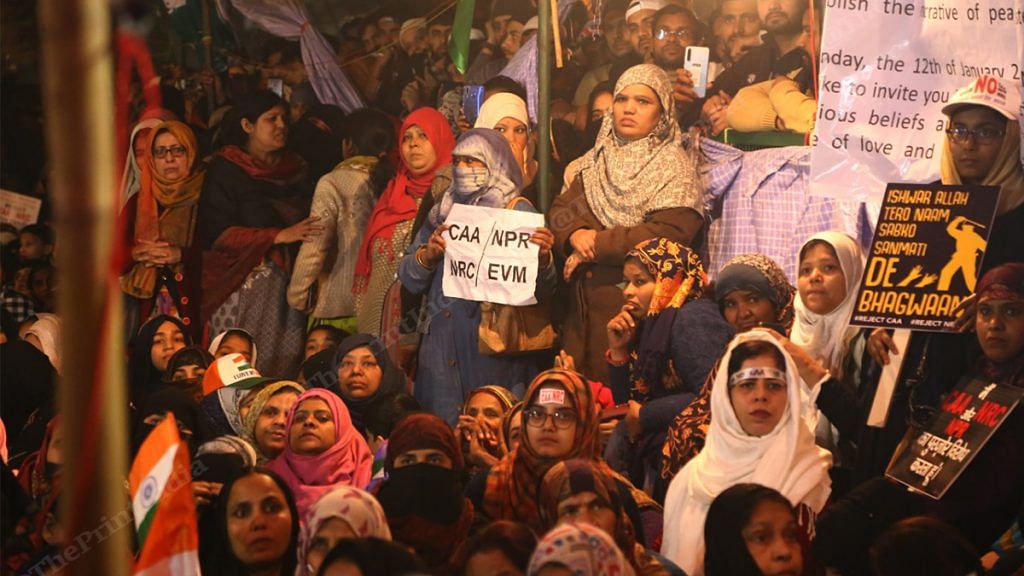Shaheen Bagh’s women must disband. No, not for the reasons Home Minister Amit Shah or BJP’s Kapil Mishra want. The novel coronavirus pandemic is a good reason for the protesting Muslim women at New Delhi’s Shaheen Bagh to end their 91-day sit-in. But that is not the only reason. Now that Delhi Chief Minister Arvind Kejriwal has passed a resolution rejecting the new NPR format and the NRC exercise, joining 12 states and union territories, it is a fine moment for the women to declare a near-victory.
But the Left and the ‘progressive’ activists who keep fuelling the Shaheen Bagh protests don’t have a tendency to focus on tactical deliverables. For them, the idea of lambi ladai or the long struggle is a goal in itself. It’s like campus politics – impressive slogans, Instagrammable posts, speeches and loads of idealism. This is important and energises any movement, but at some point, hard-nosed recalibration must set in.
Sit-ins can’t be endless, movements are.
And so, I have been asking anti-CAA and anti-NRC activists one question since February: What is a realistic endgame for Shaheen Bagh? But I found no good answers. What’s the goal? What’s the face-saver? Of course, in an ideal world, protests can go on endlessly. But in the real world, every smart protester must have an exit strategy. Of course, no protester begins with an exit strategy. When you begin, you want nothing less than Total Revolution. But mid-course, some strategic thinking must and often does come into play.
So, February was a good time to ask this question. But the activists were quite clueless. They hadn’t thought through. Mainly because there was no one group spearheading these protests. There were many disparate groups pooling in their resources. Not everyone agreed on the endgame. Also, Shaheen Bagh had by now prompted other protests in Lucknow, Patna, Bengaluru and Kolkata. So ‘scaling up’ across India became the goal for many.
Shaheen Bagh’s women protested undeterred through the most vitriolic election in Delhi and the worst Hindu-Muslim violence in years. They have been branded as ‘jihadis’ and traitors. Now, the women must count their gains – both tangibles and intangibles – cut their losses, and leave. And leaving must not be perceived as retreat or defeat.
Also read: Do Shaheen Bagh protesters run risk of waning interest or should stay put for CAA endgame?
Real and symbolic
People praised ‘Shaheen Bagh ki dadis’ — the old Muslim women who have been protesting non-stop since December. But this is precisely the demographic that is now extremely vulnerable to the coronavirus pandemic. The number of coronavirus positive cases has already climbed to 108 in India. In Italy, the average age of 105 people who died of COVID-19 was 81. In China, “the average fatality rate is 2.3%, but it changes significantly with age — rising to nearly 15% among those over 80 years old,” reported the World Economic Forum.
In India, cinema screenings, IPL cricket matches, weddings and large gatherings are being cancelled or postponed. The continuing presence of so many people – and the elderly — under the Shaheen Bagh tent in Delhi is now a looming health hazard. In December and January, it may have been heady to share videos of the old, determined women saying “kagaz nahin dikhayenge” to protest NRC and CAA paperwork, but the Ides of March is here now. People are circulating coronavirus fatalities’ videos now.
The protesters will not find a better ‘get out’ moment.
I am not saying Shaheen Bagh’s women must go back home. Protests are hugely empowering for all women – whether they are rural, urban, middle class, poor. It releases important ideas of agency and autonomy and they can never really retreat from that. The image of Shaheen Bagh and similar protests helped many Indians re-imagine a kind and positive image of politics. People should not wait for it to be undone slowly by religious groups and other negative elements.
With an especially unresponsive and obstinate BJP government in power – one that won’t engage with citizen protesters and at the same time, diminish them with remarks about their clothes and veiled threats of violence — there was never a real prospect of a negotiated rollback. This isn’t a government that gives in.
Even the UPA government under Manmohan Singh had called Anna Hazare protesters for talks after a few days of sit-in. But Shaheen Bagh women had to return without meeting Amit Shah when they tried to march to his residence to talk, after the Delhi election.
But second-wave feminism gave an important mantra. Take what you get and build on it.
Also read: On NPR, should states trust Home Minister Amit Shah’s repeated assurances?
Real and ideal
The foot soldiers of any protest must be given two options — the ideal goal and the realistic takeaway. There must be a conversation about the latter between the organisers and the foot soldiers.
Protests and sit-ins often end after police crackdown and violence – like with the Hong Kong demonstrations, Occupy Wall Street protests or Ramdev gathering at Ramlila Maidan in 2011.
Or, if they are smartly planned, the protest ends with some face-saving Plan B takeaway – like with at least the promise of Jan Lokpal Bill.
That moment of pragmatic realism has come for Shaheen Bagh women. States, including JD(U)-BJP-ruled Bihar, are pushing back, and Amit Shah has said there will be no “Doubtful” category of citizens in NPR (however unconvincingly and reluctantly). Coronavirus with no known cure isn’t going to help.
Shaheen Bagh has now become an exercise with diminishing returns.
Views are personal.
